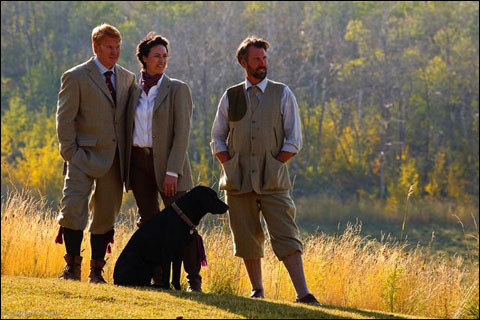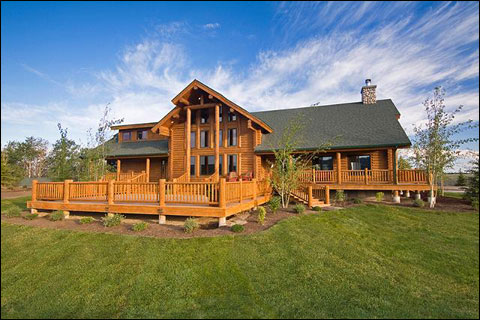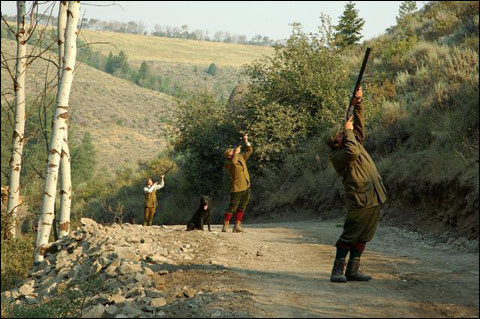The Art of the Driven Shoot:A Visit to Lazy Triple Creek Ranch

I bring my best to Lazy Triple Creek Ranch – my best guns, my best clothing, my best accessories and my best cigars. Lazy Triple Creek Ranch induces the best as iron filings are drawn to a magnet. In July, my wife Nancy and I visited Lazy Triple Creek Ranch to experience its clay target offerings, savor its cuisine, traverse its new hunting acreage and become educated about the art of the driven shoot.
I had first visited Lazy Triple Creek Ranch in the fall of 2009, and I was eager to return. It’s situated in Newdale, Idaho, nestled in the Big Hole Mountains, about a one hour drive west from Jackson Hole, Wyoming. I was also looking forward to once again meeting Lars and Jen Magnusson — the couple that operates the shooting program at the ranch.
 Lars and Jen Magnusson with Matt Whindle, gamekeeper of the Lazy Triple Creek Ranch.
Lars and Jen Magnusson with Matt Whindle, gamekeeper of the Lazy Triple Creek Ranch.Lars and Jen formed Blixt & Co. to help new and existing land owners create hunting and shooting activites on their private land. They subsequently started a new service called OnPeg.com that offers shooting around the world. In 2009 Blixt & Co. obtained the exclusive sporting rights at Lazy Triple Creek Ranch. The estate consists of 2,200 paradisiacal acres of wheat, corn, and sunflower fields, grasslands and dramatic canyons anchored by a refinished lodge of palatial expanse and style that will satisfy the most fastidious luxury traveler.
On that first visit, I had hunted a no-bag-limit driven pheasant and partridge shoot, and participated in several exciting “walk up” hunting events. My most vivid recollection of that visit occurred on the walk-up hunt: a flurry of more than fifty pheasant took flight, their wings beating the air like thundering helicopter rotors. It was a stunning sight, and my only experience similar to it was dove hunting in Cordoba, Argentina, when clouds of dove erupted from sunflower fields and blackened the air in a surreal exhibit of Nature’s grandeur.
A person brings his or her best guns and accoutrement because of the elegance and culture at Lazy Triple Creek Ranch. Every aspect of the place is aligned with the driven shooting tradition, so the allure to complement the beauty and tradition is powerful. I brought a gorgeous Watson & Hancock 12-bore sidelever hammergun, a 12-bore Beretta SO 3 EELL that, I regret, has seen very little time on the clays courses or in the field, and a 20-bore FAMARS Poseidon, one of the most beautiful shotguns ever to touch my shoulder.
Lazy Triple Creek Ranch offers several clay target formats: a skeet field, a five-stand, a sporting clays course and its signature presentation of the simulated driven bird shoot. Lars advances a specific theory regarding his clay target courses. He does not cater to the competition shooter. Rather, the clay target formats are directed toward the live driven shoot, each intended to provide opportunities to practice for the driven sport.
 The lodge at Lazy Triple Creek Ranch
The lodge at Lazy Triple Creek Ranch.
Lars let us experience the shooting courses as if they were our own personal fiefdoms. He generously supplied ammunition with a graphic of the Ranch’s name and logo on the hulls. For my vintage hammergun, however, I brought handloads put together with Hodgdon/IMR 7625 powder, producing very safe pressures in the 5000 psi range.
We began shooting the five stand mid morning on our first day. The course is beautiful, carved out of dense forest growth. Several targets, being about fifty yards distant, test the mettle of any shooter. One maddening sixty yard crosser did get the blood pressure into undesirable ranges. I used all of my guns, a rare and quite joyous opportunity.
The sporting clays course has fourteen stations and meanders through terrain varying from open fields to mildly mountainous ups and downs. The course is located within one of the “drive” areas of the driven bird sectors. We walked on a dirt road from station to station, with most of the paths being bounded by lush growths of pine and aspen. The fauna and earth were damp from the evening rain, filling the air with delicious fragrances. I rate the course as above average in difficulty in terms of courses not set specifically for tournaments.
The fastest and most energetic shooting I’ve done was at the grouse butte. The butte was constructed with stone blocks in a semi-circle. The area within the stone boundary was large enough for one shooter and a loader. I had seen such clay target grouse buttes in videos created by Chris Batha but I had not shot that format. It was thrilling and unalloyed fun.
 The comprehensive clays shooting at Lazy Triple Creek prepares hunters for the fast-flying birds presented during the traditional driven shoots.
The comprehensive clays shooting at Lazy Triple Creek prepares hunters for the fast-flying birds presented during the traditional driven shoots.Nancy and I stood within the hemisphere, yelled “ready,” and a flurry of ten or twelve clays flew toward us – high, low, left, right – like a swarm of bees heading toward a hive. Focusing on each target was undermined by the aerial activity that engaged the eyes, making the game that much more difficult and more fun. A few seconds would elapse and then another flurry would launch at us. We each burned through a box of shells in perhaps two minutes, as did the other shooters as we took turns in the butte.
Still, the most exciting clays format was Lazy Triple Creek Ranch’s signature clay target event, the simulated driven bird shoot. Each location is denominated a drive and each drive has the traditional marking of pegs. The ranch has six drives or primary shooting areas, for the clays shooting named The Bank, Boneyard, Buddha West, Baldy’s, The Mohican and Peerpost West. We began the shoot early morning after a hearty breakfast of bacon, eggs, pancakes, muffins, coffee, tea and assorted juices. Just as with the live driven bird shoots, the guns and loaders were transported to the drive location in a custom gun wagon imported from England. We started at the Boneyard drive.
 Lars Magnusson blows the traditional hunter’s horn during a driven shoot at Lazy Triple Creek Ranch.
Lars Magnusson blows the traditional hunter’s horn during a driven shoot at Lazy Triple Creek Ranch.The six of us “guns” stood with a loader at a peg down in a draw facing a steep ridge. The first order of business was a safety lecture by Lars: how to hold the gun while emphasizing the safe limitation on swinging the gun while tracking a clay target. The lecture was simplified, of course, because no dogs or beaters would invade our shooting area. Lars, dressed elegantly in a tweed suit with plus fours, stood up the line by peg one and began the “hunt” with the traditional sounding of the hunter’s horn as if beginning a shoot at legendary British shooting estates such as Elveden, Holkham or Sandringham.
The targets came out in a sequence of flurries, at dramatic heights and angles, filling the sky with clay disks. The barrels became hot and even the glove on my left hand did not protect me completely. This target format is comforting and, to some degree, I am more disposed to the clay target version than the live bird shoot. I took more challenging shots at greater distances and at wider angles because my concern for wounding a chunk of clay was minimal. My mind was not burdened with thoughts of accidentally shooting a dog or a beater. And I could shoot a lot, a tremendous number of shots, which is what I really enjoy.
In his illuminating book, “THE BIG SHOTS: Edwardian Shooting Parties,” Jonathan Garnier Ruffer offers the vignette when King George V and his son, Edward, Prince of Wales, shot with Lord Burnham in December 1913 on a record day at Barn Hall, killing nearly 4,000 pheasant. Ruffer writes, “In the train going home, the Prince of Wales noticed that the King was unusually silent. At last he said quietly, “Perhaps we overdid it today.” I didn’t have those worries or concerns. If I could have shot 4,000 clays, I would have been delighted.
What’s in a Name?
“What’s in a name?” Juliet asked in Scene II of Shakespeare’s Romeo and Juliet. “That which we call a rose,” Juliet reasoned, “by any other name would smell as sweet.” True enough when discussing roses, I acknowledge, but if the name is “driven shooting” rather than roses, then that name can encompass significantly different types of game management, presentation and quality of experience. The name matters.
During our first dinner, Lars asked me, “As a journalist, how do you interpret the phrase “driven shoot?” I confessed I had not given the issue much thought. I’d read about driven shoots, such as in Ruffer’s book; I’d talked about driven shoots with colleagues such as Chris Batha and Dale Tate, and I’d seen advertisements in shooting magazines promoting driven shoots but, I had to admit, I was not informed or educated about the breadth of variation of the sport that falls under that phrase.
 Some 30 beaters drive pheasants over a ravine where a line of “guns” waits for them at the Lazy Triple Creek Ranch.
Some 30 beaters drive pheasants over a ravine where a line of “guns” waits for them at the Lazy Triple Creek Ranch.The word and concept of “driven” shooting, Chris Batha informed me, is derived from the French word “battue,” which means beat or drive in that context. The driven shoot developed as a consequence of the technological advancements in shotgun design, beginning with those of the great John Manton. Better guns allowed the shooter to become more effective on flying birds. Quantity of kills was the initial criteria for success of a driven shoot, but that changed to quality of the shoot, which meant high flying birds. The terms European and Continental shoots means little more than that a bird is induced to fly high over the guns, whether by release from elevated points such as a tower or driven to attain altitude by beaters and or dogs.
Traditional driven shooting, what some writers refer to as “pure” driven shooting, is based on the English estate model that incorporates an ideology of terrain management and cultivation and the method of acquiring, raising and releasing the birds. Birds were raised on the estate from eggs or chicks or purchased as pultes, birds of about six weeks old, then placed in release pens and then released in the wild where they would accommodate to the terrain of the property.
Most shooters are primarily interested in the quality and challenge of the birds and may not care how the birds were raised or how they got to fly over their heads. The argument goes, if you can present the bird on challenging terrain, then it’s a good shoot and the shooter is pleased. Lars sees the process differently. To him, the game involves much more than getting birds over the guns. Lars is a traditionalist that believes deeply in the tradition and ethos of the classical driven shoot and all that is incorporated within that tradition: the elegant clothing, the etiquette and ethics of the hunt, the fine food and the attention to terrain and cultivation of food crops and cover for the birds. How a bird is released and how it was raised matter to Lars, based on not only theoretical or philosophical considerations but, he asserts, the resultant quality of the bird and thus, the shooting experience.
Lars purchases birds that are about sixteen weeks old and keeps them in pens only for one or two days. Idaho law prohibits the release of birds before August 1st. Food and water are placed near the pens. Significantly, Lars releases the birds five to six weeks before the hunting season begins, enabling the birds to acclimatize to their surroundings. The birds remain in the shooting area not as a consequence of pens and boxes but as a consequence of the scientific and rather expensive process of habitat management. There is a considerable cost to this traditional approach to managing the birds: the level of predation is high.
Lars sees the cost as worth the final more authentic product. Birds more oriented toward the habitat are more challenging to control, are stronger and offer a more exciting experience. Experienced shooters such as Jim Wear, the elite leather craftsman from Laramie, Wyoming, said the Ranch produces some of the highest flying birds he’s seen anywhere.
Lars explains that his clients do care about his replicating the authenticity of the classical driven shoot and they value his commitment and investment in offering free ranging birds. Although driving birds from location to location is a labor-intensive and demands a greater infrastructure, he exclaims, “One result is that you can get a flurry of one hundred birds, which you cannot get in a release format. That’s fabulous!” Lars suggests that the consumer should understand the different formats of presentation that are lumped together under the generic term “driven shoot.”
Consistent with the sporting philosophy, Jen has formed a partnership with preeminent bespoke tailor, Leonard Logsdail, clothier to Savile Row, Hollywood and the subject of numerous laudatory article, and created the clothing line, Logsdail Classics. This new line of country clothing will be “off the rack” but with custom options that provide that bespoke touch, or, as Jen explained, “Clothing casually elegant for the American country taste with the appearance of the British traditions.” Jen adds, “We are trying to set a standard. We try to combine the finest hunting experience with the finery and elegance of the entire hunting estate experience.”
Lars has committed to a vision, a marvelous image, despite the cost and additional effort required. I have visited the Ranch twice and can state with some authority that his standards are about as high as his pheasants fly. He combines quality presentations of pheasants and partridge with sportsmanship and etiquette. There’s a little bit of Scotland and Sandringham in the Big Hole Mountains of Idaho because of Lars’ and Jen’s dedication to this unique shooting venue.
I congratulate any hail and hardy entrepreneur willing to take the road less traveled, especially in these times. Lars and Jen have taken that road and, for them and the Lazy Triple Creek Ranch, that has made all the difference to American wing shooters.
Michael Sabbeth is a lawyer in Denver, Colorado whose practice emphasizes estate planning. He lectures nationally to bar associations on the ethics of rhetoric as a legal competence and a litigation skill. He also presents to private companies and civic groups on the use of rhetoric as a management skill. As a freelance writer he has been published in many of the finest shooting and hunting magazines, including Double Gun Journal, Shooting Sportsman, Safari Magazine and Sporting Classics. He is pleased to have written many of the most comprehensive articles on the Beretta family and its fine firearms. He is also author of the groundbreaking book “The Good, The Bad & The Difference – How to Talk With Your Children About Values.” To find out more about the book, please visit http://kidsethicsbook.com.
Useful resources
The Blixt & Co. web site
The Logsdail Classic web site
The OnPeg.com web site

Michael Sabbeth is a lawyer in Denver, Colorado. He lectures on ethics and rhetoric to law associations and civic and business groups. He is the author of the The Good, The Bad & The Difference: How to Talk with Children About Values. Please visit his website at www.kidsethicsbook.com.


Comments